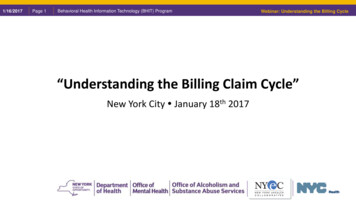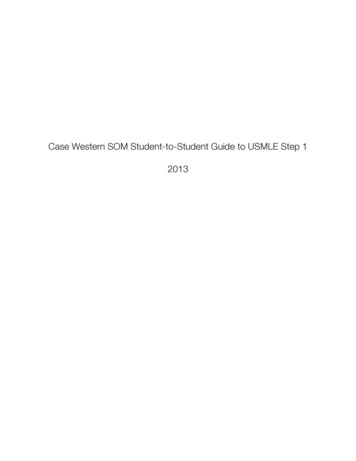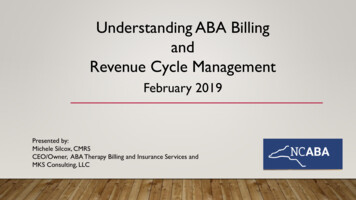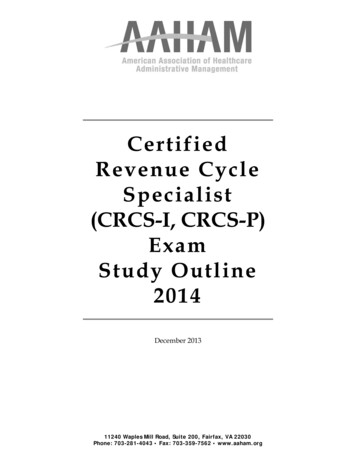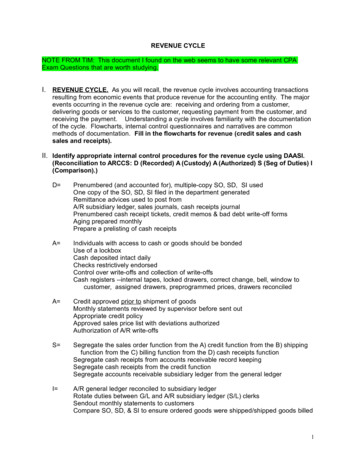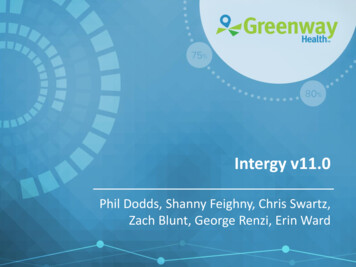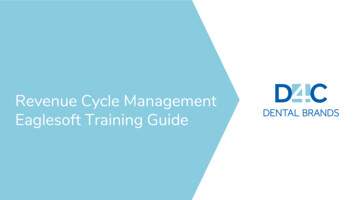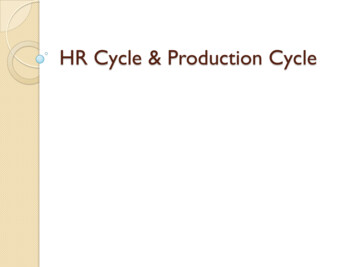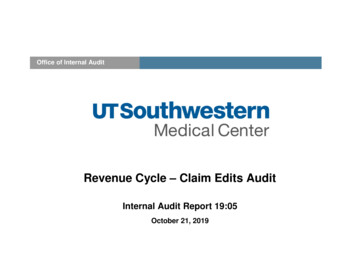
Transcription
Office of Internal AuditRevenue Cycle – Claim Edits AuditInternal Audit Report 19:05October 21, 2019
Table of ContentsI. Executive Summary··3BackgroundScope and Objectives / Conclusion34II. Detailed Observations and Action Plans Matrix7III. Appendices8··Appendix A – Risk Classifications and DefinitionsAppendix B – Claim Edits Cross-Functional Process Map19:05 Revenue Cycle – Claim Edits Audit89Page 2 of 10
Executive SummaryBackgroundThe Centers for Medicare & Medicaid Services (CMS) developed the National Correct Coding Initiative “to promote national correct codingmethodologies and to control improper coding”. The claim edits process encompasses medical providers rendering services, completingnecessary documentation, and coding procedures performed which generates charges for review/edit prior to insurance or guarantor billing.UT Southwestern uses EpicCare Ambulatory/Inpatient module to document medical services performed. Current Procedural Terminology,developed by the American Medical Association, translates procedures into charges via the charge description master file, a comprehensivelisting of services or items billable to a physician encounter Professional Billing (PB). Hospital Billing (HB) encompasses technical and nontechnical charges grouped by revenue codes belonging to a Hospital Account Record (HAR). Epic HB and PB claim modules are programmedwith billing edits to comply with the CMS coding initiatives and other payor-specific rules. UT Southwestern claim edits process automatesnecessary billing and coding checks to minimize payor denials which could delay receipt of payment. If a claim check determines that a claimedit requires manual intervention, it will route the claim to the appropriate Epic workqueue for review.The Hospital Edit Administration Workgroup (HEAW) and Edit Administrative Committee (EAC) are responsible for overseeing the Hospitaland Professional revenue cycle claim edit activities. Claim edits are primarily the responsibility of (1) Hospital Health Information Management(HIM) Coding, (2) Revenue Integrity (apart of the Hospital Decision Support team), and (3) Hospital/Professional Revenue Cycle ManagementAdministration Departments (Patient Financial Services and Front End Medical/Surgical Billing). HIM Coding is further organized into Inpatient,Outpatient Ancillary and Surgical, and Clinical Documentation. Revenue Integrity consists of audit nurses and analysts. All three groups reportto the University Hospitals Chief Financial Officer. The Department of Radiation Oncology and the Harold C. Simmons Comprehensive CancerCenter review and perform claim edits under their responsibility.The following graphic provides a high-level claims edit process overview. See appendix B for a more detailed process map.Physicians/ NursesSubmits charges inEpicEpic ChargeWorkqueuesEpic ClaimWorkqueueIdentifies chargeflags for review andresolutionIdentifies claim editsfor review andresolutionExternal ClaimReviewEpic ClaimSubmissionIdentifies claim editsfor reviewSubmits claim forreimbursement19:05 Revenue Cycle – Claim Edits AuditPage 3 of 10
Executive SummaryScope and ObjectivesThe Office of Internal Audit has completed its Revenue Cycle – Claim Edits audit. This was a risk based audit and part of the fiscal year 2019Audit Plan. Audit procedures included interviews with stakeholder; reviews of policies, procedures, and other relevant documents; dataanalytics; and substantive testing. The audit scope included FY2019 activities.The overall audit objectives were to assess the effectiveness and efficiency of operations and programs and the internal controls that ensureachievement of objectives, compliance with key regulations and institutional policies and procedures, safeguarding of assets, and accuracyof reporting. Specifically, to evaluate the processes and controls in place for managing claim edits for professional and hospital charges.We conducted our examination according to guidelines set forth by the Institute of Internal Auditors’ International Standards for theProfessional Practice of Internal Auditing.ConclusionOverall, current processes and controls enable accurate resolution of claim edits – within four days for HIM Coding and within six days forother claim edit work queues. There are opportunities to improve workqueue rules and routing to allow for clear identification by assignedgroup of workload responsibilities to review and resolve edits, which will improve efficiency. In addition, updating the communication andresponse times with the external vendor will improve flag resolution timeliness.19:05 Revenue Cycle – Claim Edits AuditPage 4 of 10
Executive SummaryThe following table summarizes the observations and the respective disposition of these observations within the UT Southwestern internalaudit risk definition and classification process. See Appendix A for Risk Rating Classifications and Definitions.Priority (0)High (0)Medium (0)Low (1)Total (1)One key improvement opportunity is summarized below.n 1. Enhance Workqueue Review Accountability – The ZIRMED claim edit work queue (WQ) does not clearly identify theworkload responsibilities to review and resolve edits for each assigned group which results in increased inefficiency and untimelyresolution of the flags.Management has implemented or is implementing corrective actions. Management responses are presented in the Detailed Observationsand Action Plans Matrix section of this report.We would like to take the opportunity to thank the department and individuals included in this audit for the courtesy extended to us and fortheir cooperation during our audit.Sincerely,Valla F. Wilson, Vice President for Internal Audit, Chief Audit ExecutiveAudit Team:Elias Dib, Senior Internal AuditorRobin Irvin, Manager of Internal AuditJeff Kromer, Director, IT & Specialty Audit ServicesMelinda Lokey, Director of Internal AuditGabriel Samuel, Internal Audit SupervisorVan Nguyen, Internal Audit Supervisor19:05 Revenue Cycle – Claim Edits AuditPage 5 of 10
Executive SummaryCc:Candace Baer, Associate Vice President, Ambulatory OperationsArnim E. Dontes, Executive Vice President, Business AffairsKathryn Flores, Assistant Vice President and Chief Information Officer, University HospitalsKimberly Huffman, Director for Patient Access Services, University HospitalsKelly Kloeckler, Associate Vice President, Revenue Cycle OperationsTim Leary, Assistant Director, HSIR Technical ServicesMark Meyer, Chief Financial Officer, University HospitalsMarc Milstein, Vice President and Chief Information Officer, Information ResourcesVinod Nair, Director, Revenue Cycle and Business Systems, Information ResourcesTerry Neal, Director, Decision Support, University HospitalsDennis Pfeifer, Assistant Vice President and Chief Technology Officer, Health SystemTodd Prine, Manager for Reimbursement & Edit Administration Committee Contact, Professional ServicesBrian Rasmus, Associate Vice President, Finance Practice PlanMark Rauschuber, Associate Vice President and Chief Information Officer, Health SystemKrystal Richardson, Director, Revenue Cycle Operations, Patient Financial Services, University HospitalsBrent Townsend, Director, Front End Medical/Surgical Billing, Revenue Cycle OperationsRhonda Walker, Director, HIM Coding and Clinical Documentation Integrity, University HospitalsJohn Warner, M.D., MBA Executive Vice President Health System Affairs & Chief Executive Officer, University Hospitals19:05 Revenue Cycle – Claim Edits AuditPage 6 of 10
Detailed Observations and Action Plans MatrixObservationRisk Rating: Low n1. Enhance Workqueue Review AccountabilityThe ZIRMED/Waystar claim edit work queues (WQ)are not clearly identifying the workloadresponsibilities to review and resolve edits for eachassigned group. Specifically, accounts with multipleedit flags require repeated reviews andresubmissions by individual assigned owners beforeall edit flags are cleared for billing, which results inincreased inefficiency and untimely resolution of theflags.The ZIRMED/Waystar WQ’s capture accounts withedit flags identified by a third party vendor and arejointly monitored by Revenue Integrity, HospitalCentral Billing Office and other responsible processowners. The WQ routing rules are linked to thestandard message received from the third partyvendor rather than the actual flag itself which iscreating the inefficiencies.Recommendation1. Evaluate the following enhancementopportunities:· Grouping claim edits by the actualedit context,·Creating separate WQs byresponsible owners rather than onejoint WQ in order to improveprocessing efficiency andaccountability, and/or·Following up with the vendor toleverage Epic activity codes totransfer billing edit accounts toappropriate WQs.2. Coordinate with Information Resources(IR) team to create an opencommunication loop withZIRMED/Waystar to allow for real timeissue status and reduce time to clearedits.Management ResponseManagement Action Plans:1. A meeting was scheduled in earlyOctober with a peer Epic client to obtainadvice on ZIRMED WQ routingsuggestions. The meeting confirmedthat UTSW’s set up and configurationsare in line with this peer’s setup. Onedifference that was noted, however,was that this peer Epic client’s WQ arenot split as granularly as UTSWoperations, but it also showed that theyhave similar issues as UTSW. ThisEpic client was able to get an additionalreport from Waystar that showed theexact logic that Waystar is using tobuild their edits. In the past, UTSW hadasked to receive the same report andwas denied access to it. This reportwould have allowed us to preciselymirror the Waystar logic in Epic, whichis now performed manually.2. Waystar is working on an enhancementto their software that allows sites tomap error codes by edit, instead oftaking their standard error code. Thishas been our (and other Epic clients)main issues with WQ routing. Waystarexpects to complete their softwaredevelopment in late November.19:05 Revenue Cycle – Claim Edits AuditPage 7 of 10
Detailed Observations and Action Plans MatrixObservationRecommendationManagement Response3. Update communication/response linkwith ZIRMED/Waystar to allow for realtime issue review and response.Action Plan Owners:Director, Revenue Cycle and BusinessSystemsAssistant Vice President and ChiefInformation Officer, University HospitalsDirector, Revenue Cycle Operations,Patient Financial ServicesTarget Completion DatesDecember 31, 2019 – Plan developed(depending upon software delivery fromWaystar)March 31, 2020 – Testing completed andmove to production19:05 Revenue Cycle – Claim Edits AuditPage 8 of 10
Appendix A – Risk Classifications and DefinitionsAs you review each observation within the Detailed Observations and Action Plans Matrix of this report, please note that we have included a colorcoded depiction as to the perceived degree of risk represented by each of the observations identified during our audit. The following chart is intendedto provide information with respect to the applicable definitions and terms utilized as part of our risk ranking process:Degree of Risk and Priority of ActionRisk Definition- Thedegree of risk thatexists based upon theidentified deficiencycombined with thesubsequent priority iumLowAn issue identified by Internal Audit that, if not addressed immediately, has ahigh probability to directly impact achievement of a strategic or importantoperational objective of a UT institution or the UT System as a whole.A finding identified by Internal Audit that is considered to have a high probabilityof adverse effects to the UT institution either as a whole or to a significantcollege/school/unit level. As such, immediate action is required by managementin order to address the noted concern and reduce risks to the organization.A finding identified by Internal Audit that is considered to have a mediumprobability of adverse effects to the UT institution either as a whole or to acollege/school/unit level. As such, action is needed by management in order toaddress the noted concern and reduce the risk to a more desirable level.A finding identified by Internal Audit that is considered to have minimalprobability of adverse effects to the UT institution either as a whole or to acollege/school/unit level. As such, action should be taken by management toaddress the noted concern and reduce risks to the organization.It is important to note that considerable professional judgment is required in determining the overall ratings presented on the subsequent pages ofthis report. Accordingly, others could evaluate the results differently and draw different conclusions. It is also important to note that this report providesmanagement with information about the condition of risks and internal controls at one point in time. Future changes in environmental factors andactions by personnel may significantly and adversely impact these risks and controls in ways that this report did not and cannot anticipate.19:05 Revenue Cycle – Claim Edits AuditPage 9 of 10
Appendix B – Revenue Cycle Process19:05 Revenue Cycle – Claim Edits AuditPage 10 of 10
Revenue Integrity consists of audit nurses and analysts. All three groups report to the University Hospitals Chief Financial Officer. The Department of Radiation Oncology and the Harold C. Simmons Comprehensive Cancer Center review and perform claim edits under their responsibility. The following graphic provides a high-level claims edit process overview. See appendix B for a more detailed .
